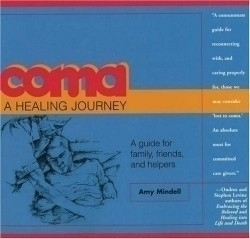Coma
A Healing Journey
Coma: the word conjures frightening images of bodily entrapment and suffering; a suspended animation between life and death; a horrible enough condition when it befalls fellow human beings and a nightmare when it befalls a loved one. While many may think of a coma as being associated with catastrophic injury or illness, and therefore somewhat remote, it is really often part of the normal dying process. In this immensely hopeful, helpful and readable book Mindell gives the reader factual information and reframes the term coma as an “altered state of consciousness” that can be worked with and learned from.
Mindell, a clinical psychologist with a background in dance and movement therapy, has worked with comatose patients and their loved ones for several years. In Coma she has written a book that orients both loved ones and professional “helpers” to techniques she has learned from working and communicating with patients. It is worth noting that Arnold Mindell, who has also worked and written extensively on consciousness, altered states and coma is the author’s husband and partner. He has written the foreword to this work and is quoted at length from a transcript of a videotaped interview at the end.
Coma is very well researched, documented and organized. Divided into four parts, it is presented in the straightforward style of a teaching manual. The book opens with a theoretical discussion of causes and characteristics of different types of coma. The assumptions of the standard medical treatments are contrasted with Mindell’s “process-oriented” view of coma. The gist of which is that while the medical paradigm views coma as a pathological problem in need of fixing, the process-oriented view is that comatose states “reflect deep, altered states of consciousness in which the person is going through potentially meaningful inner experiences” that are natural; rather than curing, the helper’s role is to “try to assist the person’s inner experiences.” Through that assistance the patient is more readily able to move out of the coma; either into death or a return to normal waking life.
The second and third parts of the book present detailed instructions for communicating with and assisting the comatose person to process their inner experience. These techniques rely on sensitive observation of the patient and both verbal and non-verbal communication. Seventy-two drawings illustrate the techniques; and summaries and reminders are boxed off in table format for reference. The fourth part of the book contains case histories and philosophical reflections. A glossary, bibliography and index are also included.
This book will be of interest to any lay person who, faced with a loved one in a coma, needs ready information and compassionate advice. It will also be useful to therapists, nurses, physicians and anyone who seeks to provide compassionate care to the comatose person.
Reviewed by
Steven Holl
Disclosure: This article is not an endorsement, but a review. The publisher of this book provided free copies of the book to have their book reviewed by a professional reviewer. No fee was paid by the publisher for this review. Foreword Reviews only recommends books that we love. Foreword Magazine, Inc. is disclosing this in accordance with the Federal Trade Commission’s 16 CFR, Part 255.

